Hyundai Tucson 2008 Owner's Manual

2008 
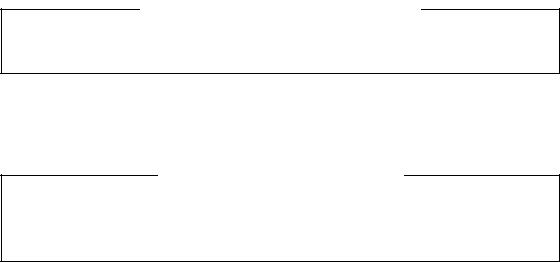
A010A02A-AAT
WARRANTIES FOR YOUR HYUNDAI VEHICLE
Please consult your Owner's Handbook & Warranty Information booklet for your vehicle's specific warranty coverage.
A020A01A-AAT
RESPONSIBILITY FOR MAINTENANCE
The maintenance requirements for your new Hyundai are found in Section 5. As the owner, it is your responsibility to see that all maintenance operations specified by the manufacturer are carried out at the appropriate intervals. When the vehicle is used in severe driving conditions, more frequent maintenance is required for some operations. Maintenance requirements for severe operating conditions are also included in Section 5.
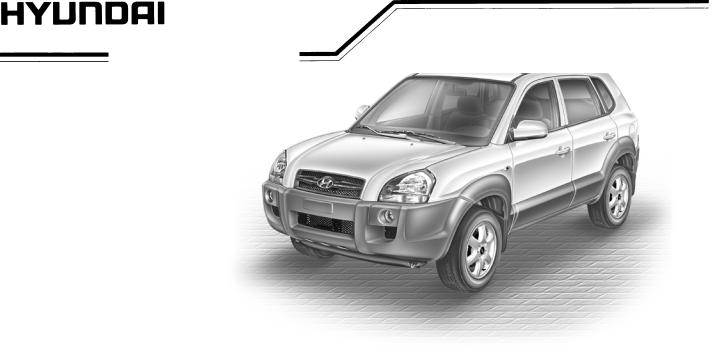
OWNER'S MANUAL
A030A01JM-AAT
Operation
Maintenance
Specifications
A030A01JM
All information in this Owner's Manual is current at the time of publication. However, Hyundai reserves the right to make changes at any time so that our policy of continual product improvement may be carried out.
This manual applies to all Hyundai  models and includes descriptions and explanations of optional as well as standard equipment. As a result, you may find material in this manual that does not apply to your specific vehicle.
models and includes descriptions and explanations of optional as well as standard equipment. As a result, you may find material in this manual that does not apply to your specific vehicle.
F1
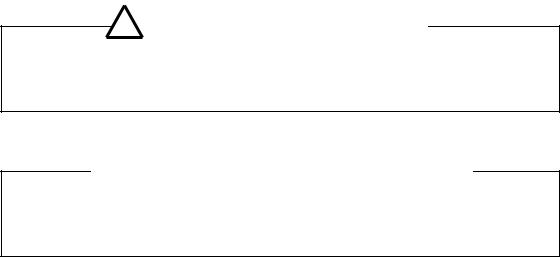
A070A01A-AAT
!CAUTION: MODIFICATIONS TO YOUR HYUNDAI
Your Hyundai should not be modified in any way. Such modifications may adversely affect the performance, safety or durability of your Hyundai and may, in addition, violate conditions of the limited warranties covering the vehicle. Certain modifications may also be in violation of regulations established by the U.S. Department of Transportation and other federal or state agencies.
A080A01S-AAT
TWO-WAY RADIO OR CELLULAR TELEPHONE INSTALLATION
Your vehicle is equipped with electronic fuel injection and other electronic components. It is possible for an improperly installed/adjusted two-way radio or cellular telephone to adversely affect electronic systems. For this reason, we recommend that you carefully follow the radio manufacturer's instructions or consult your Hyundai dealer for precautionary measures or special instructions if you choose to install one of these devices.
F2

A090A01A-AAT
SAFETY AND VEHICLE DAMAGE WARNING
This manual includes information titled as WARNING, CAUTION and NOTE.
These titles indicate the following:
!WARNING:
This indicates that a condition may result in harm, serious injury or death to you or other persons if the warning is not heeded. Follow the advice provided with the warning.
!CAUTION:
This indicates that a condition may result in damage to your vehicle or its equipment if the caution is not heeded. Follow the advice provided with the caution.
NOTE:
This indicates that interesting or helpful information is being provided.
F3

A110A01A-AAT
VEHICLE DATA COLLECTION AND EVENT DATA RECORDERS
Your Hyundai vehicle is equipped with many high technology, electronically controlled systems that help to ensure your vehicle operates properly and provides the performance that you expect. These systems utilize computers to monitor the operation of various systems and components and help to control their operation. These computerized system operations are wide-ranging and involve components to reduce emissions, to continuously evaluate the readiness of the airbag and seat belt pretensioner systems, to determine when the airbag and seat belt pre-tensioner systems should be deployed and then to activate the deployment, and if equipped, to operate anti-lock braking, traction control and electrical stability control to assist the driver to control the vehicle in difficult driving situations. These systems electronically store information that is useful to service technicians when they need to diagnose and repair these systems. Additional information is stored only when a crash occurs that results in the deployment of the airbags or seat belt pre-tensioners. This type of data storage is done by devices called event data recorders(EDR).
After a crash event, the airbag and seat belt pre-tensioner computer system, known as the Supplemental Restraint System Control Module (SRSCM) or Airbag Control Unit (ACU), may record some information about the condition of the vehicle and how it was being operated. This information consists of data related to seat belt usage and if there was diagnostic information in the airbag or seat belt systems at the time that a crash occurred, and if the ACU sensed that a crash of sufficient severity occurred to require seat belt pre-tensioner or airbag deployment.
To retrieve this information, special equipment is needed and access to the vehicle or the device that stores the data is required. Hyundai will not access information about a crash event or share it with others except:
o in response to an official request of police or similar government office, or
o with the consent of the vehicle owner or, if the vehicle is leased, with the consent of the lessee, or o as part of Hyundai’s defense of litigation, or
o as required by law.
F4

A040A01A-AAT
FOREWORD
Thank you for choosing Hyundai. We are pleased to welcome you to the growing number of discriminating people who drive Hyundais. The advanced engineering and high-quality construction of each Hyundai we build is something of which we're very proud.
Your Owner's Manual will introduce you to the features and operation of your new Hyundai. It is suggested that you read it carefully because the information it contains can contribute greatly to the satisfaction you receive from your new car.
The manufacturer also recommends that all service and maintenance on your car be performed by an authorized Hyundai dealer. Hyundai dealers are prepared to provide high-quality service, maintenance and any other assistance that may be required.
A050A04A-AAT
HYUNDAI MOTOR COMPANY
Note : Because future owners will also need the information included in this manual, if you sell this Hyundai, please leave the manual in the vehicle for their use. Thank you.
!CAUTION:
Severe engine and transaxle damage may result from the use of poor quality fuels and lubricants that do not meet Hyundai specifications. You must always use high quality fuels and lubricants that meet the specifications listed on Page 9-4 in the Vehicle Specifications section of the Owner's Manual and which also appear in the Service Station Information on the back cover of the Owner's Manual.
Copyright 2008 Hyundai Motor Company. All rights reserved. No part of this publication may be reproduced, stored in any retrieval system or transmitted in any form or by any means without the prior written permission of Hyundai Motor Company.
F5

A100A03A-AAT
Guide to Hyundai Genuine Parts
1.What are Hyundai Genuine Parts?
Hyundai Genuine Parts are the same parts used by Hyundai Motor Company to manufacture vehicles. They are designed and tested for the optimum safety, performance, and reliability to our customers.
2.Why should you use genuine parts?
Hyundai Genuine Parts are engineered and built to meet rigid manufacturing requirements. Using imitation, counterfeit or used salvage parts is not covered under the Hyundai New Vehicle Limited Warranty or any other Hyundai warranty. In addition, any damage to or failure of Genuine Hyundai Parts caused by the installation or failure of
A100A01L
an imitation, counterfeit or used salvage part is not covered by any Hyundai Warranty.
3.How can you tell if you are purchasing Hyundai Genuine Parts?
Look for the Hyundai Genuine Parts Logo on the package (see below).
HyundaiGenuinePartsexportedtotheUnited States are packaged with labels written only in English.
Hyundai Genuine Parts are only sold through authorized Hyundai Dealerships.
A100A02L
To find the closest authorized dealer call
1-800-826-CARS
A100A03L
A100A04L
F6

TABLE OF CONTENTS
SECTION
FEATURES OF YOUR HYUNDAI |
1 |
DRIVING YOURHYUNDAI |
2 |
WHAT TO DO IN AN EMERGENCY |
3 |
CORROSION PREVENTION & APPEARANCE CARE |
4 |
VEHICLE MAINTENANCE REQUIREMENTS |
5 |
DO-IT-YOURSELFMAINTENANCE |
6 |
EMISSION CONTROL SYSTEMS |
7 |
CONSUMER INFORMATION, REPORTING SAFETY DEFECTS & |
8 |
BINDING ARBITRATION OF WARRANTY CLAIMS |
|
VEHICLE SPECIFICATIONS |
9 |
|
|
INDEX |
10 |
|
|
|
F7 |

INSTRUMENTSANDCONTROLS
B250A01JM-AAT
B250A01JM-U
F8

1.Panel Brightness Control Knob (Rheostat Switch)
2.4WD Lock Switch (If installed)
3.Traction Control System (TCS) Switch (If installed) / Electronic Stability Control (ESC) Switch (If installed)
4.Instrument Cluster
5.Multi-Function Light Switch (If installed)
6.Front Window Defroster (If installed) / Aux Outlet (If installed)
7.Hazard Warning Light Switch
8.Digital Clock
9.Windshield Wiper/Washer Switch
10.Rear Defroster and Outside Rearview Mirror Heater Switch (If installed)
11.Front Fog Light Switch (If installed)
12.Passenger's Airbag
13.Hood Release Lever
14.Horn and Driver's Airbag
15.Small Article Tray / Ashtray (If installed)
16.Cruise Control Switch (If installed)
17.Heating/Air Conditioning Control Panel (If installed)
18.Shift Lever (If installed)
19.Glove Box
!CAUTION:
When installing a container of liquid air freshener inside the vehicle, do not place it near the instrument cluster nor on the instrument panel surface. If there is any leakage from the air freshener onto these areas (Instrument cluster, instrument panel or air ventilator), it may damage these parts. If the liquid from the air freshener does leak onto these areas, wash them with water immediately.
F9

YOUR VEHICLE AT A GLANCE
B255A03JM-AAT
INDICATOR SYMBOLS ON THE INSTRUMENT PANEL
SRS (Airbag) Service Reminder Indicator (SRI)
Turn Signal Indicator Lights
Seat Belt Reminder Light and Chime
High Beam Indicator Light
Low Oil Pressure Warning Light
Parking Brake/Brake Fluid Level Warning Light
Charging System Warning Light
Tail Gate Open Warning Light
Door Ajar Warning Light and Chime (If installed)
Low Fuel Level Warning Light
Malfunction Indicator Light
ABS Service Reminder Indicator (If installed)
Traction Control Indicator Light (If installed)
Electronic Stability Control (ESC) Indicator
Lights (If Installed)
Cruise Indicator (If installed)
SET Indicator Light (If installed)
4WD System Warning Light (If installed)
4WD Lock Indicator Light (If installed)
Low tire pressure telltale (If installed)
TPMS (Tire pressure monitoring system) malfunction indicator (If installed)
F10 * More detailed explanations of these items will be found beginning on page 1-48.

FEATURES OF YOUR HYUNDAI
Fuel Recommendations ................................................ |
1-2 |
Breaking in Your New Hyundai ..................................... |
1-3 |
Keys .............................................................................. |
1-3 |
Door .............................................................................. |
1-4 |
Power Windows .......................................................... |
1-11 |
Seats ........................................................................... |
1-12 |
Seat Belts.................................................................... |
1-18 |
Child Restraint System ............................................... |
1-25 |
Supplemental Restraint (AIRBAG) system ................. |
1-33 |
Instrument Cluster and Indicator Lights ...................... |
1-46 |
Warning and Indicator Lights ...................................... |
1-48 |
Multi-Function Light Switch ......................................... |
1-58 |
Windshield Wiper/Washer Switch ............................... |
1-60 |
Sunroof ....................................................................... |
1-68 |
Mirror ........................................................................... |
1-73 |
How to use Luggage Room ........................................ |
1-79 |
Hood Release ............................................................. |
1-84 |
Cruise Control ............................................................. |
1-87 |
Heating and Cooling Control ..................................... |
1-102 |
Stereo Sound System ............................................... |
1-109 |
Audio System ............................................................ |
1-111 |
Antenna ..................................................................... |
1-132 |
1
1

1FEATURESOFYOURHYUNDAI
2 |
FUEL RECOMMENDATIONS |
|
B010A05A-AAT
Use Unleaded Gasoline
UNLEADED
FUEL ONLY
B010A01JM
Unleaded gasoline with a Pump Octane Rating of 87 (Research Octane Number 91) or higher must be used in your Hyundai.
!WARNING:
oDo not "top off" after the nozzle automatically shuts off when refueling.
oTighten the cap until it clicks, otherwise the " " light will illuminate.
oAlways check that the fuel cap is installed securely to prevent fuel spillage in the event of an accident.
B010B01A-AAT
What About Gasohol?
Gasohol (a mixture of 90% unleaded gasoline and 10% ethanol or grain alcohol) may be used in your Hyundai. However, if your engine develops driveability problems, the use of 100% unleaded gasoline is recommended. Fuels with unspecified quantities of alcohol, or alcohols other than ethanol, should not be used.
B010C01A-AAT
Use of MTBE
Hyundai recommends that fuels containing MTBE (Methyl Tertiary Butyl Ether) over 15.0% vol. (Oxygen Content 2.7% weight) should not be used in your Hyundai.
Fuel containing MTBE over 15.0% vol. (Oxygen Content 2.7% weight) may reduce vehicle performance and produce vapor lock or hard starting.
B010D01A-AAT
Do Not Use Methanol
Fuels containing methanol (wood alcohol) should not be used in your Hyundai. This type of fuel can reduce vehicle performance and damage components of the fuel system.
!CAUTION:
Your Hyundai's New Vehicle Limited Warranty may not cover damage to the fuel system and any performance problems that are caused by the use of fuels containing methanol or fuels containing MTBE (Methyl Tertiary Butyl Ether) over 15.0% vol. (Oxygen Content 2.7% weight.)

|
|
|
FEATURESOFYOURHYUNDAI 1 |
|
BREAKINGINYOURNEWHYUNDAI |
KEYS |
3 |
|
|
|
|
B010E01A-AAT |
B020A01S-AAT |
B030A01A-AAT |
|
Gasolines for Cleaner Air
To help contribute to cleaner air, Hyundai recommends that you use gasolines treated with detergent additives, which help prevent deposit formation in the engine. These gasolines will help the engine run cleaner and enhance performance of the Emission Control System.
B010F01A-AAT
Operation in Foreign Countries
If you are going to drive your Hyundai in another country, be sure to:
oObserve all regulations regarding registration and insurance.
o Determine that acceptable fuel is available.
During the First 1,200 Miles (2,000 Km)
No formal "break-in" procedure is required with your new Hyundai. However, you can contribute to the economical operation and durability of your Hyundai by observing the following recommendations during the first 1,200 miles (2,000 km).
o Don't drive faster than 55 MPH (88 km/h).
oWhile driving, keep your engine speed (rpm, or revolutions per minute) between 2,000 rpm and 4,000 rpm.
oUse moderate acceleration. Don't start quickly or depress the accelerator pedal fully.
oFor the first 200 miles (300 km), try to avoid hard stops.
oDon't lug the engine (in other words, don't drive so slowly in too high a gear that the engine "bucks"-shift to a lower gear).
oWhether going fast or slow, vary your speed from time to time.
oDon't let the engine idle longer than 3 minutes at one time.
oDon't tow a trailer during the first 1,200 miles (2,000 km) of operation.
B030A01HR
For greater convenience, the same key operates all the locks in your Hyundai. However, because the doors can be locked without a key, carrying a spare key is recommended in case you accidentally lock one key inside the car.

1FEATURESOFYOURHYUNDAI
4 |
|
DOOR LOCKS |
B030B01A-AAT |
B030C01JM-AAT |
B040A01A-AAT |
Record Your Key Number
B030B01HR
A code number is stamped on the number plate that came with the keys to your Hyundai. This key number plate should not be left with the keys but kept in a safe place, not in the vehicle. The key number should also be recorded in a place where it can be found in an emergency.
If you need additional keys, or if you should lose your keys, your authorized Hyundai dealer can make new keys if you can supply the key number.
ILLUMINATED IGNITION SWITCH (If installed)
B030C01E-1
Whenever either front door is opened, the ignition switch will be illuminated for your convenience, provided the ignition switch is not in the "ON" position.
The light will go off approximately 10 seconds after closing the door or when the ignition switch is turned on.
!WARNING:
oUnlocked doors can be dangerous. Before you drive away (especially if there are children in the car), be sure that all the doors are securely closed and locked so that the doors cannot be opened from the inside. This helps ensure that the doors will not be opened accidentally. Also, when combined with the proper use of seat belts, locking the doors helps keep occupants from being ejected from
the car in case of an accident.
oBefore opening the door, always look for and avoid oncoming traffic.
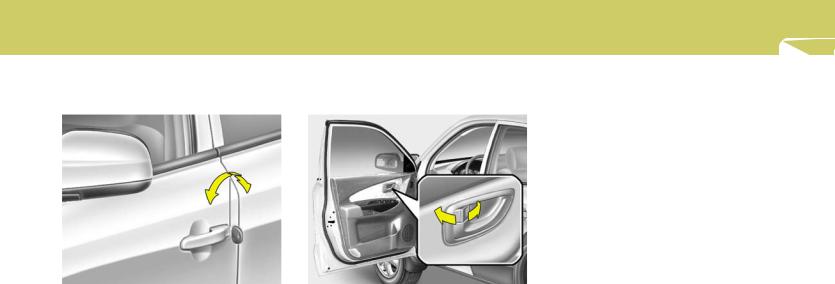
FEATURESOFYOURHYUNDAI 1
5
B040B01JM-AAT |
B040C02O-AAT |
Locking, unlocking front doors with a |
Locking From the Outside |
key |
(Driver's side - without key) |
UNLOCK
LOCK
NOTE:
oWhen pushing the lock switch of the driver's door to the "LOCK" position, only the driver's door can be locked.
oIf your vehicle is equipped with the central door locking system, the door will not lock if the key is left in the ignition switch when the front doors are closed.
oWhen locking the door this way, be careful not to lock the door with the ignition key left in the vehicle.
oTo reduce the chances of theft, always remove the ignition key, close all windows, and lock all doors and the tail gate when leaving your vehicle unattended.
HJM2007 |
B040C01JM |
oThe door can be locked or unlocked with a key.
oLock the door by turning the key toward the front of the vehicle and unlock it by turning the key toward the rear.
NOTE:
The driver's door can be unlocked by turning the key once toward the rear. If you wish to unlock all doors, turn the key again toward the rear within 4 seconds. The passenger's side will lock or unlock all doors with just one rotation.
The doors can be locked without a key. To lock the doors, first push the inside lock switch to the "LOCK" position so that the red mark on the switch is not visible, then close the door.

1FEATURESOFYOURHYUNDAI
6
B040D01O-AAT
Locking From the Inside (Driver's side)
LOCK
UNLOCK
HJM2008
To lock the door from the inside, simply close the door and push the lock switch to the "LOCK" position.
NOTE:
oWhen pushing the lock switch of the driver's door to the "LOCK" position, only the driver's door can be locked.
oWhen the door is locked, the red mark on the switch is not visible.
oThe driver's door can be opened by pulling the inside door handle even if the lock switch is depressed.
B045C01JM-AAT
Locking From the Outside (Passenger's side - Without key)
B045C01JM
The door can be locked without a key. To lock the door, first push the inside lock switch to the "LOCK" position so that the red mark on the switch is not visible, then close the door.
NOTE:
oWhen pushing the lock switch of the passenger's door to the "LOCK" position, only the passengers door will be locked.
oIf your vehicle is equipped with the central door locking system, the door will not lock if the key is left in the ignition switch when the front doors are closed.
oWhen locking the door this way, be careful not to lock the door with the ignition key left in the vehicle.
oTo reduce the chances of theft, always remove the ignition key, close all windows, and lock all doors and the tail gate when leaving your vehicle unattended.
B045D01JM-AAT
Locking From the Inside (Passenger's side)
UNLOCK
LOCK
HJM2008-D
To lock the door from the inside, simply close the door and push the lock switch to the "LOCK" position. When this is done, neither the outside nor the passenger's inside door handles can be used.
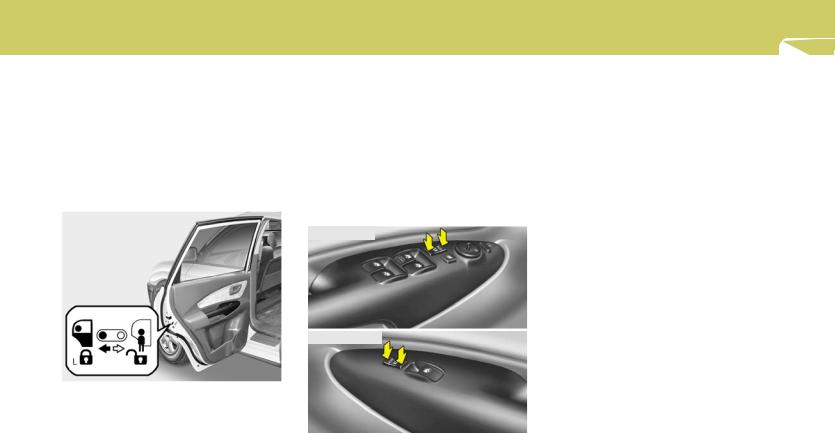
FEATURESOFYOURHYUNDAI 1
7
NOTE:
oWhen pushing the lock switch of the passenger's door to the "LOCK" position, only the passenger's door locks.
oWhen the door is locked, the red mark on the switch is not visible.
B040E04A-AAT
Child-Protector Rear Door Lock
HJM2011
Your Hyundai is equipped with left and right side "child-protector" rear door locks. When the lock mechanism is engaged, the rear door cannot be opened from the inside. Its use is recommended whenever there are small children in the rear seat.
To engage the child-protector feature so that the door cannot be opened from the inside, move the child-protector lever to the "  " position and close the door. Move the lever to the "
" position and close the door. Move the lever to the "  " position when normal door operation is desired.
" position when normal door operation is desired.
To open the door from the outside, pull the outside door handle.
B040G03HP-AAT
Central Door Locks
Driver's door
HJM2010
Passenger's door
HJM2120
The central door locking switch is located on the front door arm rest. It is operated by depressing the door lock switch.
NOTE:
oWhen pushing the front portion of the switch, all vehicle doors will lock. If any door is open when the switch is depressed, the door will remain locked when closed.
oWhen pushing the rear portion of the switch, all vehicle doors will unlock.
oThe central door locking is operated by turning the key in the front door lock toward the front or rear of the vehicle.
NOTE:
If the door is locked/unlocked multiple times in rapid succession with either the vehicle key or door lock switch, the system may stop operating temporarily in order to protect the circuit and prevent damage to system components.
B070F03O-AAT
KEYLESS ENTRY SYSTEM (If installed)
NOTE:
This device complies with Part 15 of the FCC rules. Operation is subject to the following two conditions:
(1) This device may not cause harmful interference, and (2) this device must accept any interference received, including interference that may cause undesired operation.
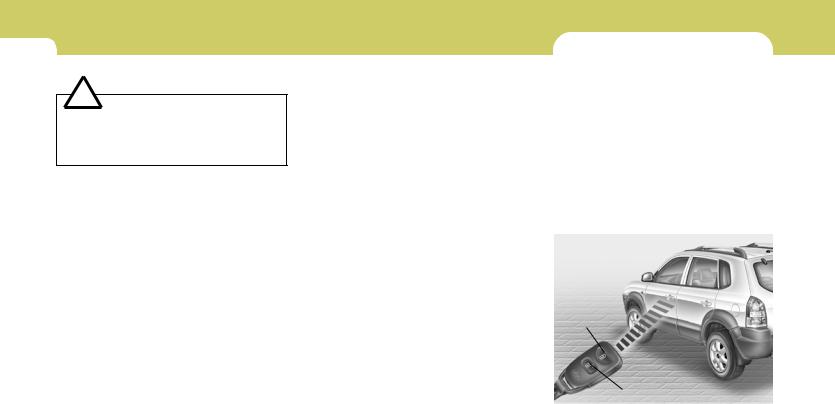
1FEATURESOFYOURHYUNDAI
8 |
THEFT-ALARM SYSTEM |
|
!CAUTION:
Changes or modifications not expressly approved by the party responsible for compliance could void the user's authority to operate the equipment.
Locking doors
1.Close all doors.
2.Push the "LOCK" button on the transmitter.
3.At the same time all doors lock, the turn signal lights will blink once to indicate that the system is armed.
Unlocking doors
1.Push the "UNLOCK" button on the transmitter.
2.At the same time the driver's door unlocks, the turn signal lights will blink twice to indicate that the system is disarmed.
NOTE:
If you wish to unlock all doors, press the "UNLOCK" button on the transmitter again within 4 seconds.
NOTE:
The transmitter will not work if any of following occur:
-The ignition key is in ignition switch.
-You exceed the operating distance limit (393.7 inches [10 m]).
-The battery in the transmitter is weak.
-Other vehicles or objects may be blocking the signal.
-The weather is extremely cold.
-The transmitter is close to a radio transmitter such as a radio station or an airport which can interfere with normal operation of the transmitter.
When the transmitter does not work correctly, open and close the door with the ignition key. If you have a problem with the transmitter, contact an authorized Hyundai Dealer.
NOTE:
Keep the transmitter away from water or any liquid. If the keyless entry system is inoperative due to exposure to water or liquids, it will not be covered by your manufacturer vehicle warranty.
B070A01A-AAT
(If installed)
This system is designed to provide protection from unauthorized entry into the car. This system is operated in three stages : the first is the "Armed" stage, the second is the "Alarm" stage and the third is the "Disarmed" stage. If triggered, the system provides an audible alarm with blinking of the turn signal lights.
B075B01O-AAT
Armed Stage
LOCK
UNLOCK |
B070B02JM |
Park the car and stop the engine. Arm the system as described below.
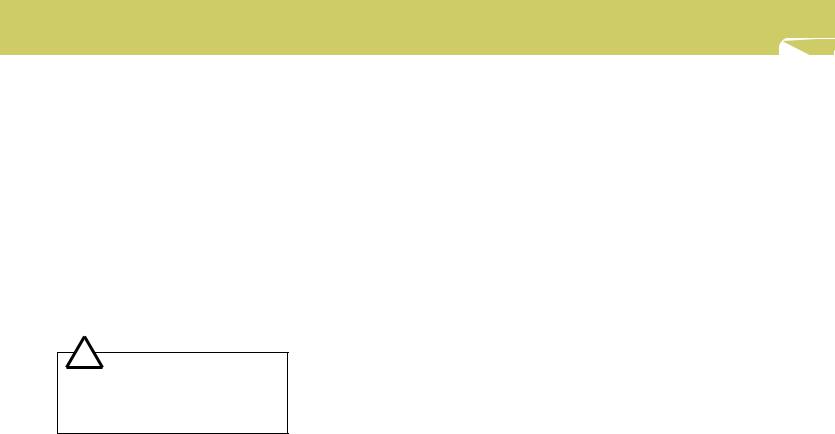
FEATURESOFYOURHYUNDAI 1
9
1)Remove the ignition key from the ignition switch.
2)Make sure that the hood and tail gate are closed and latched.
3)Lock the doors using the transmitter of the keyless entry system.
After completion of the steps above, the turn signal lights will blink once to indicate that the system is armed.
NOTE:
oIf any door, the tail gate or engine hood remains open, the system will not be armed. If this happens, rearm the system as described above.
oIf the "LOCK" button is pressed once more within 4 seconds after pushing the "LOCK" button on the transmitter, the siren will sound once to indicate that the system is armed.
B075C01JM-AAT
Alarm Stage
The alarm will be activated if any of the following occurs while the car is parked and the system is armed.
1)A front or rear door is opened without using the transmitter or the ignition key.
2)The tail gate is opened without using the transmitter or the ignition key.
3)The hood is opened.
The siren will sound and the turn signal lights will blink continuously for about 30 seconds (This will repeat 3 times). To turn off the system, unlock the door or tail gate using the transmitter or the ignition key.
B075D01JM-AAT
Disarmed Stage
The system will be disarmed by using the transmitter or the ignition key.
The driver's door is unlocked by depressing once the "UNLOCK" button on the transmitter. If you wish to unlock all doors, press the "UNLOCK" button on the transmitter again within 4 seconds.
Whenever the step above is completed, the turn signal lights will blink twice to indicate that the system is disarmed.
NOTE :
The system will rearm if a door, tailgate, or hood is not opened within 30 seconds.
!CAUTION:
Do not arm the system until all passengers have left the car. If the system is armed while a passenger(s) remains in the car, the alarm may be activated when the remaining passenger(s) leaves the car.

1FEATURESOFYOURHYUNDAI
10
B075E01JM-AAT
Panic Warning
PANIC
B075E01JM
1.Push the "PANIC" button on the back side of the transmitter.
2.At the same time, the siren will sound and the turn signal lights will blink for 30 seconds.
3.To turn off the system, push the "PANIC" button again on the transmitter.
B070E02HP-AAT
Replacing the battery
When the transmitter's battery begins to get weak, it may take several pushes on the button to lock or unlock the doors. Replace the battery as soon as possible.
Battery type : CR2032
Replacement instructions:
Screwdriver
Battery
Case
B070E01JM
2.Remove the old battery from the case and note the polarity. Make sure the polarity of the new battery is the same(+side facing down), then insert it in the transmitter.
B070E02JM
1.Carefully separate the case with a blade screwdriver as shown in the illustration.

FEATURESOFYOURHYUNDAI 1
POWER WINDOWS |
11 |
|
B060A03Y-AAT
B060A03JM
The power windows operate when the ignition key is in the "ON" position. The main switches are located on the driver's armrest and control the front and rear windows on both sides of the vehicle. The windows may be opened by depressing the appropriate window switch and closed by pulling up the switch. To open the window on the driver's side, press the switch halfway down. The window moves as long as the switch is operated. To fully open the driver's window automatically, press the switch fully down. In automatic operation, the window will fully open even if you let go of the switch. To stop at the desired opening, pull up and release the switch.
HJM2017
In order to prevent operation of the passenger front and rear windows, a window lock switch is provided on the armrest of the driver's door. To disable the power windows, press the window lock switch. To revert to normal operation, press the window lock switch a second time.
NOTE:
The power windows can be operated for 30 seconds after the ignition key is turned to the "ACC" or "LOCK" positions, or removed from the ignition switch.
If the front doors are opened during this 30 second period, the power windows can no longer be operated without the ignition key turned to the "ON" position.
Close Open
HJM2016
!WARNING:
(1)Be careful that someone's head, hands and body are not trapped by a closing window.
(2)Never try to operate the main switch on the driver's door and the individual door window switch in opposing directions at the same time. If this is done, the window will stop and cannot be opened or closed.
(3)Do not leave children alone in the car. Always remove the ignition key for their safety.

1FEATURESOFYOURHYUNDAI
12 SEATS
B080A02A-AAT
ADJUSTABLE FRONT SEATS
!WARNING:
oNever adjust the driver’s seat while the vehicle is moving. Any sudden or unexpected movement of the seat could cause you to lose control of the vehicle resulting in an accident. Only adjust the driver’s seat when the vehicle is stationary.
oDo not sit or lean unnecessarily close to the airbag. Position the seat so that you can sit as far back as possible from the airbag and still comfortably reach all controls.
B080B03A-AAT
Adjusting Seat Forward and Rearward
HJM2031
To move the seat toward the front or rear, pull the lock release lever upward. This will release the seat on its track so you can move it forward or rearward to the desired position. When you find the position you want, release the lever and slide the seat forward or rearward on its track until it locks into the desired position and cannot be moved further.
!WARNING:
After adjusting the seat, always check that it is securely locked into place by attempting to move the seat forward or reverse without using the lock release lever. Sudden or unexpected movement of the driver's seat could cause you to lose control of the vehicle resulting in an accident.
B080C03A-AAT
Adjusting Seatback Angle
HJM2033
To recline the seatback, lean forward to take your weight off it, then pull up on the recliner control lever at the outside edge of the seat.
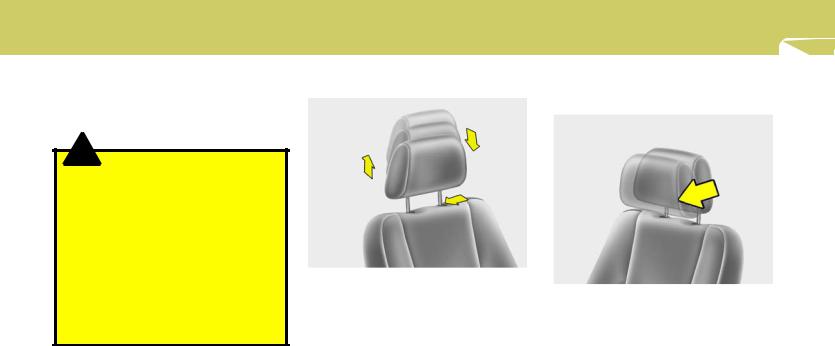
FEATURESOFYOURHYUNDAI 1
13
Now lean back until the desired seatback angle is achieved. To lock the seatback into position, release the recliner control lever.
!WARNING:
Riding with a reclined seatback increases your chance of serious or fatal injuries in the event of a collision or sudden stop. The protection of your restraint system (seat belts and airbags) is greatly reduced by reclining your seat. Seat belts must be snug against your hips and chest to work properly. The more the seatback is reclined, the greater the chance that an occupant's hips will slide under the lap belt or the occupant's neck will strike the shoulder belt. Drivers and passengers should always sit well back in their seats, properly belted, and with the seatbacks upright.
B080D02JM-AAT
Adjustable Headrests
Lock Knob
HJM2044
Headrests are designed to help reduce the risk of neck injuries.
To raise the headrest, pull it up. To lower the headrest, push it down while pressing the lock knob. To remove the headrest, raise it as far as it can go then press the lock knob while pulling upward. This should only be done when the seat is not occupied.
B080E01JM-GAT
Forward and backward adjustment (if installed)
HJM2045-2
The headrest may be adjusted forward to three different positions by pulling the headrest forward. To adjust the headrest backward, pull it fully forward to the farthest position and release it. Adjust the headrest so that it properly supports the head and neck.
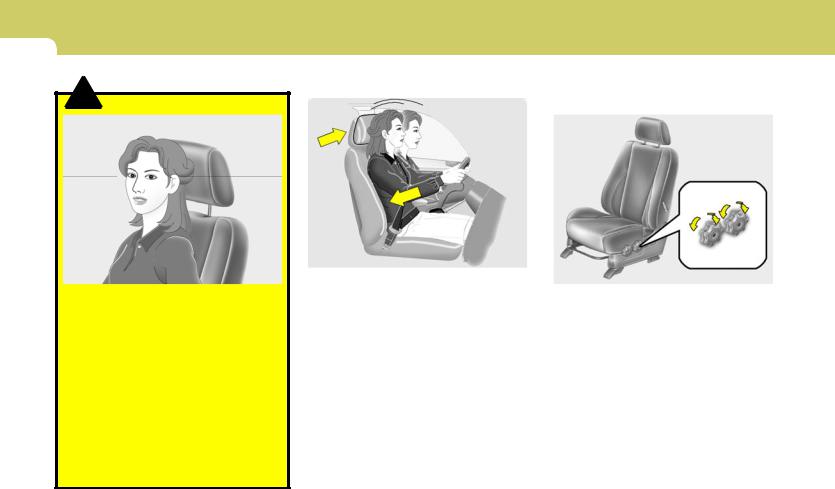
1FEATURESOFYOURHYUNDAI
14
B083D01NF-AAT |
B080F01A-AAT |
!WARNING:
B080D01JM
oFor maximum effectiveness in case of an accident the headrest should be adjusted so the middle of the headrest is at the same height as the top of the occupant's eyes. For this reason, the use of a cushion that holds the body away from the seatback is not recommended.
oDo not operate vehicle with the headrests removed as injury to the occupants may occur in the event of an accident. Headrests may provide protection against neck injuries when properly adjusted.
oDo not adjust the headrest hejght while the vehicle is in motion.
Active Headrests (If Installed)
HNF2041-1
The active headrest is designed to move forward and upward during a rear impact. This helps to prevent the driver's and front passenger's head from moving backward and thus helps prevent neck injuries.
Seat Cushion Height Adjustment
(Driver's Seat Only) (If Installed)
HJM2035
To raise or lower the front part of the seat cushion, turn the front knob forward or rearward. To raise or lower the rear part of the seat cushion, turn the rear knob forward or rearward.
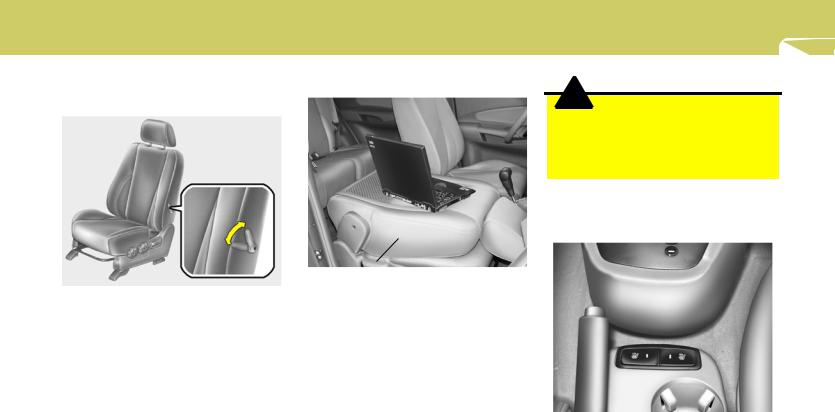
FEATURESOFYOURHYUNDAI 1
15
B080E01F-AAT |
B080H02JM-GAT |
Lumbar Support Control (Driver's seat only) (If Installed)
SOFT
FIRM
HJM2036
The driver's seat is equipped with adjustable lumbar support.
To increase the amount of lumbar support, pull the lever forward.
To decrease it, push the lever toward the rear.
Seatback table (if installed) |
! WARNING: |
|
||
|
|
|
|
|
|
|
|
o Do not sit on the seatback table. |
|
|
|
|
o Do not place items on the seatback table |
|
|
|
|
when the vehicle is in motion. |
|
|
|
|
o Do not leave items on the seatback table |
|
|
|
|
when the vehicle is in motion. |
|
|
|
|
B100A02JM-AAT |
|
Recliner control lever |
SEAT WARMER (If installed) |
|||
|
|
|
|
|
|
HJM2041 |
|
|
|
|
|
|
|
|
The seatback table is made by folding the front passenger seat forward.
To operate the seatback table
1.Lower the headrest.
2.With the recliner control lever pulled up, fold the front passenger seatback forward to the flat position.
3.When returning the seatback to the upright position, ensure the seatback is completely locked into place.
HJM2042
The seat warmer is provided to warm the front seats during cold weather. With the ignition key in the "ON" position, push either of the switches to warm the driver's seat or the passenger's seat.

1FEATURESOFYOURHYUNDAI
16
During mild weather or under conditions where the operation of the seat warmer is not needed, keep the switches in the "OFF" position.
NOTE:
oThe seat warmer will not operate if the ambient temperature is higher than 82.4°F ± 6.3°F (28°C ± 3.5°C).
oIf the seat warmer doesn't work when ambient temperature is lower than 75.2°F (24°C), it should be checked at an authorized dealer.
!WARNING:
It is recommended that the seat heater not be used when elderly people or people who are ill occupy the seat. Also, do not use the seat warmer if the occupant is sleeping.
B085A01JM-GAT
REAR SEAT
Adjusting Seatback Angle
 Seatback
Seatback
folding lever
HJM2046
To recline the seatback, pull the seatback folding lever and release it after the desired seatback angle is achieved.
When you recline the seatback to desired position, always be sure it has locked into position.
!CAUTION:
B085B02JM-AAT
Folding Rear Seatback
For convenience, the seatbacks and seat cushions may be folded down and up.
HJM2047
1.Pull the seatback folding lever then push down the seatback.
2.Be sure it has locked into position to listen an audible "Click".
When reclining the seatback, you should adjust the seatback folding lever while standing.
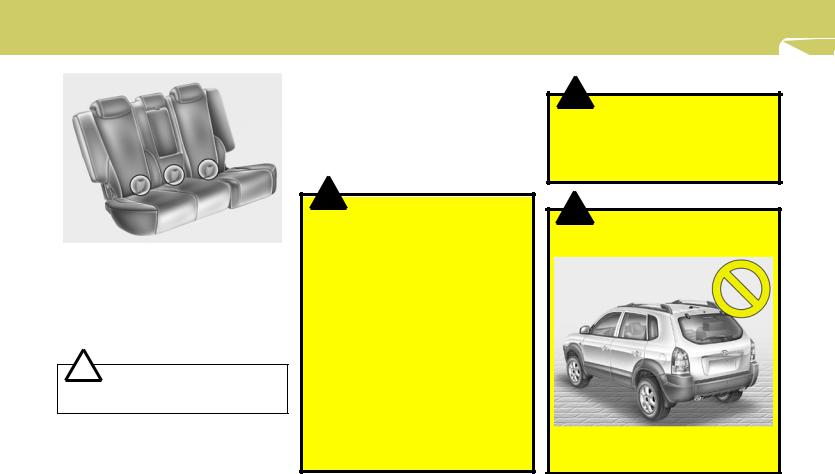
FEATURESOFYOURHYUNDAI 1
17
HJM2048
NOTE:
oBefore folding the seatback, place the rear seat belt buckles in the buckle pouch on the seatback. This will prevent the seat belt buckles from becoming covered by the seat cushion when it is returned to the seating position.
!CAUTION:
Be careful not to overload seatback. Overloading may cause damage the seatback.
3.To return the seatback to its normal position, pull the seatback folding lever and reverse the above procedure.
oWhen you return the seatback to its upright position, always be sure it is locked into position by pulling and pushing on the top of the seatback.
!WARNING:
oThe purpose of the fold-down rear seat back is to allow you to carry larger items than could otherwise be accommodated. Never allow passengers to sit on the cargo area while the car is moving. This is not a proper seating position and no seat belts are available for use when the seat back is folded down.
This could result in serious injury or death in case of an accident or a sudden stop. Objects should not extend higher than the top of the front seatbacks.
This could allow cargo to slide forward and cause injury or damage during sudden stops.
oWhen you return the rear seatback to its upright position after being folded down, be careful not to damage the seatbelt webbing or buckle. In addition, do not allow the seatbelt webbing or buckle to get caught or pinched in the rear seat.
!WARNING:
oWhen you return the rear seatback to its upright position, be sure it is locked into position. Attempt to move it.
oNever attempt to fold or return seat while the vehicle is moving.
!
B140A01B-AAT
REAR SEAT WARNING
B140A01JM
For the safety of all passengers, luggage or other cargo should not be piled higher than the top of the seatback.

1FEATURESOFYOURHYUNDAI
18 |
SEAT BELTS |
|
B150A02S-AAT
SEAT BELT PRECAUTIONS
!WARNING:
All occupants of the vehicle must wear their seat belts at all times. Seat belts and child restraints reduce the risk of serious or fatal injuries for all occupants in the event of a collision or sudden stop. Without a seat belt, occupants could be shifted too close to a deploying airbag, strike the interior structure or be thrown from the vehicle. Properly worn seat belts greatly reduce these hazards. Even with advanced airbags, unbelted occupants can be severely injured by a deploying airbag. Always follow the precautions about seat belts, airbags and occupant safety contained in this manual.
B150B04Y-AAT
Infant or Small Child
All 50 states have child restraint laws. You should be aware of the specific requirements in your state. Child and/or infant safety seats must be properly placed and installed in the rear seat. Information about the use of these restraints begins on page 1-25.
!WARNING:
Every person in your vehicle needs to be properly restrained at all times, including infants and children. Never hold a child in your arms or lap when riding in a vehicle. The violent forces created during a crash will tear the child from your arms and throw the child against the interior. Always use a child restraint appropriate for your child's height and weight, see page 1-25.
NOTE:
Small children are best protected from injury in an accident when properly restrained in the rear seat by a child restraint system that meets the requirements of the Federal Motor Vehicle Safety Standards. Before buying any child restraint system, make sure that it has a label certifying that it meets Federal Motor Vehicle Safety Standard 213. The restraint must be appropriate for your child's height and weight. Check the label on the child restraint for this information. See page 1-25.
B150C02A-AAT
Larger Children
Children who are too large for child restraint systems should always occupy the rear seat and use the available lap/shoulder belts. The lap portion should be fastened snug on the hips and as low as possible. Check belt fit periodically. A child's squirming could put the belt out of position. Children are afforded the most safety in the event of an accident when they are restrained by a proper restraint system in the rear seat. If a larger child (over age 13) must be seated in the front seat, the child should be securely restrained by the available lap/shoulder belt and the seat should be placed in the rearmost position. Children under the age of 13 should be restrained securely in the rear seat. NEVER place a child under the age of 13 in the front seat. NEVER place a rear facing child seat in the front seat of a vehicle.
B150D01A-AAT
Pregnant Women
The use of a seat belt is recommended for pregnant women to lessen the chance of injury in an accident. When a seat belt is used, the lap belt portion should be placed as low and snugly as possible on the hips, not across the abdomen. For specific recommendations, consult a physician.
